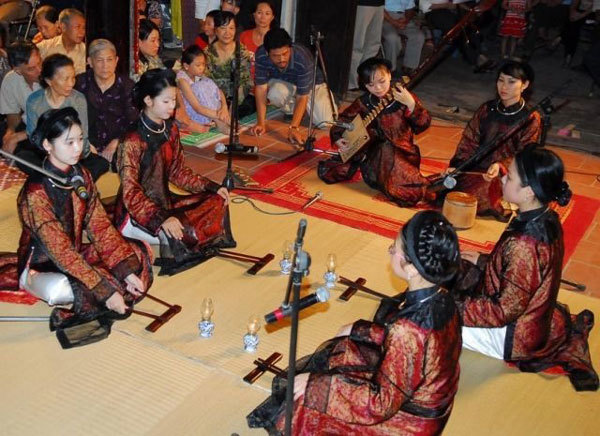Ca Tru club helps preserve traditional art form
Measures needed to preserve and promote traditional art form
 |
| A performance by the young Thang Long ca tru group at the Ngoc Ha ancient communal house in Hanoi's Ba Dinh District. VNA/VNS Photo Nhat Anh |
Researcher Bui Trong Hien has proposed setting up a general stock of ca trù.
He said currently, some examples of the singing are held by the Viet Nam Music Institute, some by the National Culture and Arts Institute, and others are owned by private collectors and researchers.
The audio is contained on CDs, DVDs, tapes and video cassettes.
“It’s important to establish a general stock of ca trù,” he said. “For example, the Viet Nam Music Institute may be responsible for setting up such a stock.”
Researcher Nguyen Quang Long agreed the task is very important.
“It will help ordinary people and ca trù singers have easier access to a systematic archive on the art,” Long said.
“The stock will help the development of the art. Making it popular again and moving it from the list of Intangible Cultural Heritages in Need of Urgent Safeguarding to one of Humankind’s Intangible Cultural Heritage, like hát xoan (folk singing from northern Phu Tho Province).”
Endangered by mould
A few years ago, Hien was doing some research on ca trù, when he borrowed ten tapes from an artist. But all of them had got mouldy. Hien had to painstakingly clean the tapes with alcohol and a soft piece of cotton. It took him two weeks to digitally record the songs from the tapes.
“When ca trù artisan Nguyen Phu De died in March at the age of 97, his fans were sad but relieved that De’s pieces of music and lyrics had been saved by Hien,” Long said.
“He also did serious research and categorised the work,” he said.
Long also recorded Nguyen Phu De’s performances five years ago as part of a project hosted by the Music Publishing House.
Long said other agencies like the Radio Voice of Viet Nam, Music Publishing House Dihavina have recorded performances by various ca trù artists to keep as archives.
“When I worked at Dihavina, I found an interesting stock of music by artisan Quach Thi Ho on cassette tapes,” Long said.
Long also revealed that though the Music Institute possesses an extensive array of recordings, it is just for reference as most of the songs were not recorded in a studio, meaning the quality is often poor.
Records by the Music Publishing House are more profitable as they can be copied for sale to the public.
Long suggested that the archives of the Music Publishing House should be digitalised for preservation.
“Unsustainable materials like cassette tapes and vinyl can degrade over time,” he said.
“Quach Thi Ho’s singing was copied to CDs in 2004-05. The CDs were then sold widely.”
Hien also stressed the need to change the sound recorded into a digital form.
“The cassette tapes may get mouldy, which affects the quality,” he said.
He also said the sound on the old tapes should be cleaned up before being transformed into digital.
“Modern software can help improve the sound,” he said.
Both researchers suggested setting up a general stock of ca trù art for researchers and new performers.
“Young singers should learn from old artisans like Thái Hà Ca Trù Group and the group run by artisan Pho Thi Kim Duc,” Long said.
Ca trù is a complex form of sung poetry found in the north of Vietnam from the 11th century on, using lyrics written in traditional Vietnamese poetic forms.
For much of its history, it was associated with a geisha-like form of entertainment, which combined entertaining wealthy people as well as performing religious songs for the royal court.
VNS
 Folk music researchers support the creation of a digital archive of ca trù (ceremonial singing) owned by a State-run agency to preserve the traditional artform and gather scattered materials owned by individual artists and researchers." itemprop="description" />
Folk music researchers support the creation of a digital archive of ca trù (ceremonial singing) owned by a State-run agency to preserve the traditional artform and gather scattered materials owned by individual artists and researchers." itemprop="description" />